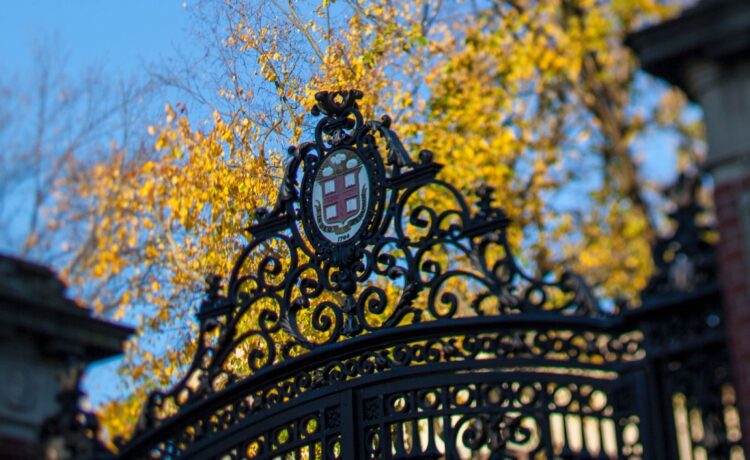PROVIDENCE, R.I. [Brown University] — University endowments, once a topic often restricted to budget meetings and fundraising conversations, are increasingly taking center stage in debates on a range of issues.
 “Endowments, especially for the nation’s wealthiest institutions, continue to be a subject of significant interest — not only within the university community, but also in the local community, among policymakers nationally and in the general public,” said Jane Dietze, Brown’s vice president and chief investment officer. “And particularly during times of social or geopolitical unrest, there is increased interest in how universities invest their endowments. Social issues often raise questions about the role of finances in societal challenges.”
“Endowments, especially for the nation’s wealthiest institutions, continue to be a subject of significant interest — not only within the university community, but also in the local community, among policymakers nationally and in the general public,” said Jane Dietze, Brown’s vice president and chief investment officer. “And particularly during times of social or geopolitical unrest, there is increased interest in how universities invest their endowments. Social issues often raise questions about the role of finances in societal challenges.”
Dietze spoke about Brown University’s endowment, ethical investing and the recurring question of divestment in an extensive Q&A.
At the conclusion of the fiscal year ending June 30, 2023, Brown’s endowment and other managed assets stood at $6.6 billion. That level of wealth prompts regular questions about how the endowment is used, how it is invested and who makes investment decisions, Dietze said.
According to Dietze, these questions are often at the center of campus and national conversations, debates and protests, but the endowment itself is something few people really understand. She and her team in the Brown Investment Office have been working to change that.
Q: For those who don’t know, please explain briefly what Brown University’s endowment is and its purpose.
The Brown endowment is a collection of donations, almost 4,000 individual gifts, that have been made to Brown since 1764 from alumni, parents and friends of the University. Each donation is codified in a gift agreement, which is a legal contract, that designates support for a specific purpose — for example, financial aid for students, endowed professorships, academic programs, research, libraries, etc. These gifts are pooled together and invested in a diversified portfolio of financial assets so that a portion of each gift — about 5% per year — can be distributed to the University’s budget for the designated purpose. The Corporation of Brown University decides how much of the endowment to spend per year.
The result of managing the capital this way is that those proceeds, that 5% annually, can continue to fund the designated purpose in perpetuity. But each year, whether returns are up or down, some part of each endowment must go to supporting its original purpose. The investments we make are designed to protect the endowment from becoming devalued over time due to inflation, and ideally, to be able to grow the impact of each gift by growing the size of the endowment.
So, in personal finance terms, it is a bit like a retirement fund that has required minimum distributions, except that it has to last forever. Our job in Brown’s Investment Office is to make prudent investments with an appropriate level of risk that can grow the endowment over time.
Q: Why do you feel it’s important for people to understand how Brown’s endowment functions?
Endowments, especially for the nation’s wealthiest institutions, continue to be a subject of significant interest — not only within the university community, but also in the local community, among policymakers nationally and in the general public. We often get questions about why we aren’t spending more, why the endowment isn’t being spent in support of various initiatives or programs, or whether or how the endowment may be funding other initiatives. And particularly during times of social or geopolitical unrest, there is increased interest in how universities invest their endowments. Social issues often raise questions about the role of finances in societal challenges.
We find ourselves in such a moment now during ongoing national and global questions about fossil fuel investment, gun violence, and the conflict in the Middle East, among other issues. And this is in addition to the regular questions about how our endowment supports the needs of our community and the institution, in areas like academic programs, compensation and financial aid. The questions raised in these moments often are based on confusion and misunderstanding about endowments. The Investment Office has been doing presentations in recent years to different groups of students, staff, faculty and alumni across the Brown community, and we continue to embrace opportunities to provide a fact-based understanding to all our stakeholders about Brown’s endowment.
One common misconception, just to give an example, is that all donations to Brown make their way to the endowment, which is not the case. Gifts to the Annual Fund from alumni, friends of Brown and other donors don’t go into the endowment; they are spent that year. Also, no funds from tuition or fees of any kind go into the endowment. Endowments are established as legal contracts with donors of large gifts who want their contributions to fund a specific purpose for the life of the institution. So that’s the type of thing we can clear up by communicating a bit more.
Q: How does Brown make investment decisions?
The complexity of the financial markets has increased dramatically in recent decades. In order to generate the appropriate risk-adjusted return for Brown, the Investment Office endeavors to partner with the most talented investors in their respective fields, such as decarbonization, biotechnology, European financial technologies, catastrophe reinsurance, specific geographies such as India or Japan, artificial intelligence, etc. Today, the majority of Brown’s endowment — about 96% — is invested with third-party managers. Our team at Brown does deep diligence on these managers and their strategies (often for several years before investing) and monitors the progress of each strategy carefully. In terms of oversight, the Investment Office is accountable primarily to the Investment Committee of the Corporation [of Brown University]. We also have Brown’s internal audit group and an external, “Big 4” auditing firm examining our books every year. Also, as with any nonprofit institution, there are laws in place that ensure our endowment is responsibly managed.
Q: Is there a mission or investment philosophy that informs investment decisions?
The stated mission of the endowment is two-fold: to both preserve and prudently grow the endowment and its income distribution capability in perpetuity to support the educational mission of the University.
The first principle is to preserve the endowment. The contribution to the University this fiscal year will be $299 million. That is subsidizing research, providing financial aid, paying salaries and countless other things essential to Brown operating every day. Brown can’t really do without that contribution; it is equivalent to 16% of the annual operating budget, so we think first about protection.
The second principle, prudently growing the endowment, exists so that this financial resource can grow its impact on the University’s mission as time goes by. In order to grow the endowment, the investment returns must be equal to the annual contribution to the University, but also must exceed inflation. This creates a kind of hurdle for the rate of investment return that we seek to clear by making long-term investments that can appreciate over time.
Brown commonly gets this question — why not spend more from the endowment? Imagine the payout rate from 2013 to 2023 was just 1% higher. Less money would be invested each year, so the endowment would have grown more slowly. In 2024, the endowment’s value would have been $900 million less than with the typical payout rate, and Brown would have $38 million less to spend on everything the endowment supports.

















